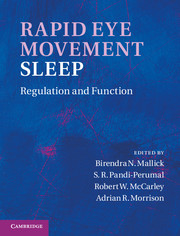Book contents
- Frontmatter
- Contents
- Contributors
- Preface
- Acknowledgments
- Organization
- Section I Historical context
- 1 The sleep–dream state: historic and philosophic perspectives
- 2 REM sleep and dreaming
- 3 REM sleep and dream sleep: are they identical?
- 4 The discovery of REM sleep: the death knell of the passive theory of sleep
- 5 REM sleep and dreaming: the nature of the relationship
- Section II General biology
- Section III Neuronal regulation
- Section IV Neuroanatomy and neurochemistry
- Section V Functional significance
- Section VI Disturbance in the REM sleep-generating mechanism
- Index
- Plate section
- References
3 - REM sleep and dream sleep: are they identical?
Exploring the conceptual developments in the Upanishads and the present knowledge based on the neurobiology of sleep
from Section I - Historical context
Published online by Cambridge University Press: 07 September 2011
- Frontmatter
- Contents
- Contributors
- Preface
- Acknowledgments
- Organization
- Section I Historical context
- 1 The sleep–dream state: historic and philosophic perspectives
- 2 REM sleep and dreaming
- 3 REM sleep and dream sleep: are they identical?
- 4 The discovery of REM sleep: the death knell of the passive theory of sleep
- 5 REM sleep and dreaming: the nature of the relationship
- Section II General biology
- Section III Neuronal regulation
- Section IV Neuroanatomy and neurochemistry
- Section V Functional significance
- Section VI Disturbance in the REM sleep-generating mechanism
- Index
- Plate section
- References
Summary
Summary
Dreams have been known to mankind from time immemorial, while rapid eye movement sleep (REMS) has been objectively defined by characteristic electrophysiological signals since the mid twentieth century only. In the absence of better objective criteria, modern experimental sleep neurobiologists have objectively identified the dream state of a subject with REMS; thus, the dream state and REMS have often been used synonymously. There are reasons to believe that those states are not exclusively correlated to each other, rather they are independent phenomena that are often expressed simultaneously; however, neurobiological explanations are still lacking. In an attempt to better understand the relationship between them, we combined findings from objective science such as non-locality in physics with that of subjective science such as the phenomenon of consciousness. We explored the wisdom in the Upanishads, especially those instances where these ancient writings refer to sleep, dream, and states of consciousness, and attempted to offer an explanation based on modern experimental science. Our search led us towards a conceptual novelty in proposing the existence of an all-inclusive basal ground state (T or Turiya), which possibly equates to very slow waves in the electroencephalogram (EEG), during which waking, dream, non-REMS (NREMS), and REMS express apparently as independent phenomena, though overlapping to various degrees on many occasions. The proposed hypothesis and model, unlike several other earlier ones, is based on known and rational physiological principles, and hence is amenable to experimental verification.
- Type
- Chapter
- Information
- Rapid Eye Movement SleepRegulation and Function, pp. 21 - 30Publisher: Cambridge University PressPrint publication year: 2011
References
- 1
- Cited by



